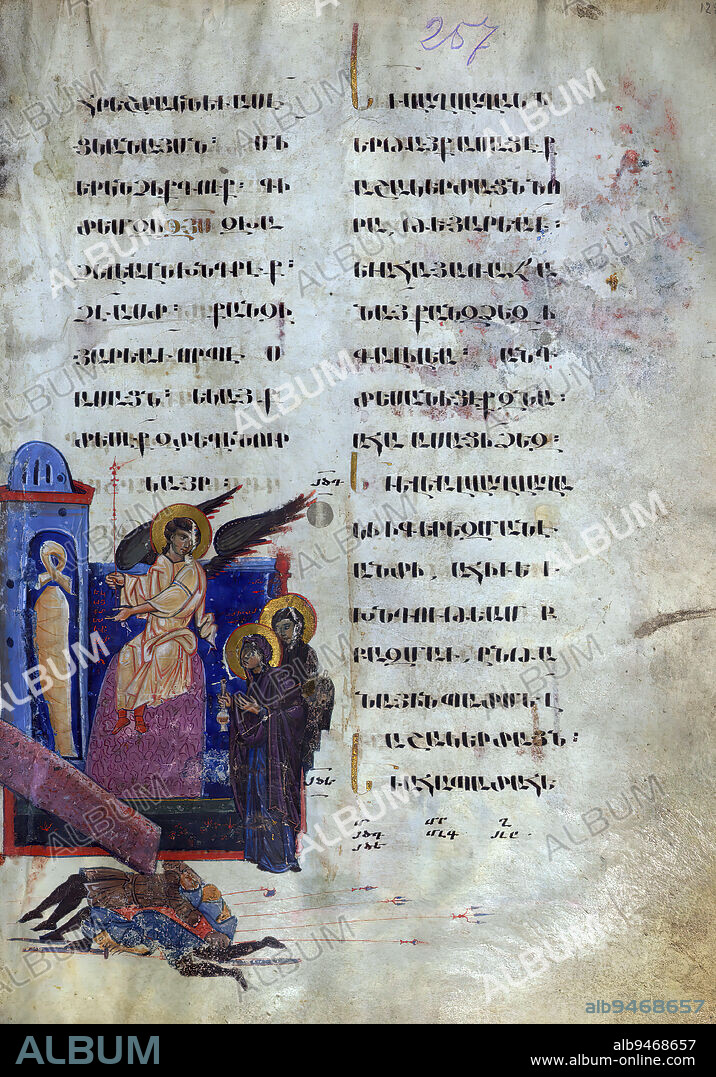alb9468657
T'oros Roslin Gospels, The holy women at the sepulchre, This manuscript was made in 1262 by Toros Roslin, an extremely prominent illuminator, who extended the range of manuscript illuminations by introducing a whole cycle of images into the gospels rather than, as was traditional, only including the portraits of the evangelists. This particular manuscript was created at the scriptorium of Hromkla, which became the leading artistic center of Armenian Cilicia under the rule of catholicos Constantine I (1221-1267).Toros created this manuscript under commission from the nephew of Constantine, a priest also named Toros. It is one of seven known manuscripts bearing Toros Roslins signature, and it is the most sumptuous of them all, with 15 miniatures and 67 smaller illustrations. The style of the images suggests that Toros had several assistants helping with the illustrations, though the overall quality remains extremely high. The manuscript was long cherished within the Armenian church. Even in the seventeenth century, its illumination served as a model for Armenian scribes, particularly Bargham and his son Mikayel; in the latter manuscript, Mikayel explicitly refers to 'the excellent scribe Toros, surnamed Roslin.'.

|
Añadir a otro lightbox |
|
Añadir a otro lightbox |



¿Ya tienes cuenta? Iniciar sesión
¿No tienes cuenta? Regístrate
Compra esta imagen
Descripción:
Ver traducción automática
T'oros Roslin Gospels, The holy women at the sepulchre, This manuscript was made in 1262 by Toros Roslin, an extremely prominent illuminator, who extended the range of manuscript illuminations by introducing a whole cycle of images into the gospels rather than, as was traditional, only including the portraits of the evangelists. This particular manuscript was created at the scriptorium of Hromkla, which became the leading artistic center of Armenian Cilicia under the rule of catholicos Constantine I (1221-1267).Toros created this manuscript under commission from the nephew of Constantine, a priest also named Toros. It is one of seven known manuscripts bearing Toros Roslins signature, and it is the most sumptuous of them all, with 15 miniatures and 67 smaller illustrations. The style of the images suggests that Toros had several assistants helping with the illustrations, though the overall quality remains extremely high. The manuscript was long cherished within the Armenian church. Even in the seventeenth century, its illumination served as a model for Armenian scribes, particularly Bargham and his son Mikayel; in the latter manuscript, Mikayel explicitly refers to 'the excellent scribe Toros, surnamed Roslin.'
Crédito:
Album / quintlox
Autorizaciones:
Modelo: No - Propiedad: No
¿Preguntas relacionadas con los derechos?
¿Preguntas relacionadas con los derechos?
Tamaño imagen:
3424 x 4896 px | 48.0 MB
Tamaño impresión:
29.0 x 41.5 cm | 11.4 x 16.3 in (300 dpi)
Palabras clave:
ARMENIA • BIZANTINA • BIZANTINO • CHRISTIAN • CODICE • CRISTIANAS • CRISTIANO • CRISTIANOS • CRISTO • CURA • ENCUADERNACION • ESCRITORIO • ESTILO • EVANGELISTA • EXTENDIDA • IGLESIA ARMENIA • ILUMINACION • ILUSTRACION • IMAGENES • JESUS • LIBRO • MANUSCRITO • MINIATURA • MODELO • PINTURA • PUPITRE • RELIGION: CRISTIANA • RETRATOS • SACERDOTE • SACERDOTES • SANTAS MUJERES • SCRIPTORIUM • SIETE • SIGLO XIII • SIGLO XVII • SOBRINO • TRADICIONAL
 Pinterest
Pinterest Twitter
Twitter Facebook
Facebook Copiar enlace
Copiar enlace Email
Email
